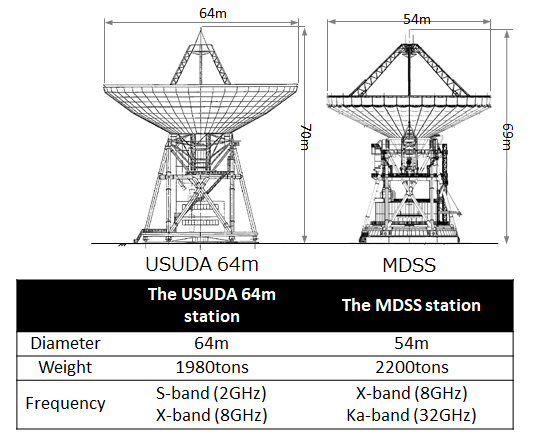Overview of MDSS (Misasa Deep Space Station)
Background developing MDSS
UDSC (Usuda Deep Space Center) has supported the missions for deep space exploration for more 30 years as the only ground station with the 64m diameters antenna in Japan.
However, the 64m antenna has already exceeded the design life of the equipment. Also, the missions recently became high level and UDSC became needed to receive much more data. Hayabusa2 launched in 2014 plans to use higher frequency (Ka-band) newly than X-band it can use. For this purpose, JAXA stared the GREAT (Ground station for deep space Exploration And Telecommunication) project to develop and upgrade a new ground station for deep space exploration in November 2015 and completed it in March 2021.
MDSS can use Ka-band to support the missions for deep space exploration from now on. It can expand to support not only deep space exploration but also moon / lagrange point missions in the future.
GREAT2 project has started in June 2021. Then purpose of this project is as follows.
- Improvement of the reliability and stability of the MDSS station (redundant system, spare parts, emergency power generation equipment)
- Add functions to support future spacecrafts (ESA: BeppiColombo, HERA, JAXA: MMO, EQUULEUS, MMX, DESTINY+, NASA: Roman) to replace the USUDA 64m station (64m is on operation at least till JFY 2023).
It will be completed by March 2024.
To secure operational capacity for JAXA to independently achieve innovative results from deep space exploration by newly enabling the receiving of Ka-band while continuing to cope with X-band communication, which has been used for a long time for deep space missions.
While decreasing the antenna diameter from 64m, the new antenna will improve its reception capacity. We will develop a comprehensive system combining a high-precision tracking antenna and transmitter-receiver against the harsh environment including solar radiation and wind pressure.
Name |
Misasa Deep Space Station (MDSS) |
Operation Start |
April 2021 (April 2024 as the system improved the reliability and stability) |
Location |
1905-43, Tateshina, Maeyama, Saku city, Nagano prefecture, Japan
East longitude 138 degrees and 21 minutes; North latitude 36 degrees and 8 minutes; Altitude 1580 m Area : 8 hectare (80000 square meters)
|
Design life |
Over 20 years |
Antenna Method |
Cassegrain antenna with shaped reflector |
Diameter |
54m |
Weight |
2240tons Approx. |
Mounting system |
Az-El |
Power supply method |
Focused beam power supply method |
Frequency |
- For tracking and control of spacecraft
X-band send (7145MHz~7235MHz)
X-band receive (8400MHz~8500MHz)
Ka-band receive (31800MHz~32300MHz)
- For geodetic VLBI
X-band (8200MHz~8700MHz)
|
Transmission performance |
X-band send gain: over 69.62dBi
X-band send power: over 20kW (EIRP over 142.5dBm)
|
Reception performance |
- X-band G/T: 53.35dB/K at an elevation angle of 15 to 80 degrees
- Ka-band G/T: 59.33bD/K at an elevation angle of 15 to 80 degrees
The above G/T is an effective G/T value that includes propagation loss (the sum of losses caused by atmospheric absorption and precipitation)
|
Comparison with the USUDA 64m station
The table below shows a comparison between the 64-meter station and the MISASA deep-space exploration ground station.
